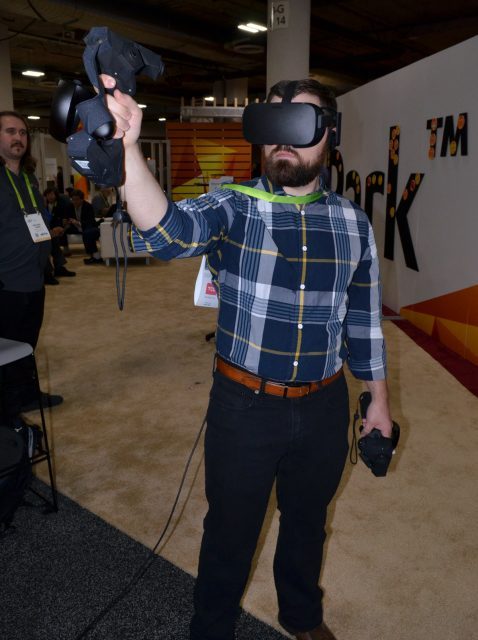Pose Potential

As I was playing with the different ways that the controllers could be connected to one another, my imagination was immediately engaged thinking about unique virtual tools, weapons, and gameplay that the controllers could enable. The company has also been exploring other poses, and showed me several other ways that the controllers could connect to one another: a top-to-top pose which could be well suited as a bike or motorcycle’s handlebars (with twisting throttle), and a top-to-bottom pose for something like a bo staff or shovel. Before deciding on the final poses, Provancher says the company wants to get a feel for which are the most compelling.
Fewer Actuators
From earlier prototypes which were using three or four actuators per-hand, the latest prototype cuts that number down to two per-hand: resulting in one sliding section on the front and one on the back of the grip. This reduces the ability of the controller to directly apply a feeling of side-to-side torque (whereas the feeling of front to back torque is very clear, thanks to the front and back sliders), but the company has adapted the feedback response to still provide some sensation of side to side movement, even if it’s more abstract than front to back.
Will Provancher, founder of Tactical Haptics, told me that moving to two actuators instead of four makes the controller more practical and durable. With just two, the actuators can be higher quality, more robust, and more reliable, Provancher said. It also makes room on the inside of each handle for a ‘grip’ button to facilitate interactions similar what’s expected with the Rift and Vive controllers.
Minimum Viable Prototype
The current prototypes are undeniably bulky as they need to make room for the actuators, battery, tracking, and the necessary mounting points for being able to attach in various poses. For ease of prototyping, each of the Tactical Haptics controllers has an entire Oculus Touch controller integrated into the handle for tracking. The company plans to build tracking hardware directly into the controller in the future, and it was clear (after holding one of the controllers with the Oculus Touch removed) that will be a major boon to the weight of the controllers. Provancher also says that the controller can be made more compact once the temporary Touch controllers are removed from the design.
– – — – –
Tactical Haptics has ambitions for a consumer version of the controller, but that’s further down the road. For now the company is piloting the reconfigurable version of the Reactive Grip controller at the IMAX VR arcade in LA, and the company hopes to see traction elsewhere in the VR location-based entertainment sector.






